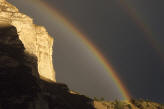|
The earlier you plan your hike and
apply for permits, the more likely you will be to get the dates and
itinerary of your choice. The earliest you can apply for a permit is the
first of the month, four months prior to the proposed start month.
Out of 30,000 requests, the park
issues 13,000 permits, and close to 40,000 people camp overnight in the
backcountry at Grand Canyon. The majority of Grand Canyon hikers are here
for the first time, and although many are avid hikers, they find that
hiking the Grand Canyon is very different from most other backpacking
experiences. They tend to react to the experience in one of two ways:
either they can't wait to get back, or they swear they'll never do it
again.
Depending upon how prepared you are
and what the canyon serves up at any particular time, your trip can be a
vacation or a challenge, a revelation or an ordeal. (
You will be hiking in a
desert climate, where water and protection from the elements make the
difference between life and death. Your trip begins at a high elevation
(7000-8000 feet) and requires a bone-jarring descent at the beginning of
your trip, when your pack is heaviest. You will face a long climb out when
you are already tired.
Grand Canyon National Park
encompasses more than 1.2 million acres, the vast majority of the park is
inaccessible due to the predominance of cliffs, and inhospitable to all
but desert plants and animals. The Colorado River bisects the canyon;
hikers can cross the river only at Phantom Ranch. If you choose to hike
from rim to river to rim, you will have to deal with an elevation
differential of more than 10,000 feet from start to finish.
If you are interested in guided
hiking and/or camping trips, please contact one of the Hiking
Guide Companies.
Rangers recommend that you plan
your trip well in advance of your arrival at the park, and when possible,
indicate flexibility as to the dates and routes you request. Permit
requests for popular hiking seasons - spring, summer, and fall - generally
must be made as early as possible. While summer is definitely not the ideal time to
hike in the canyon, it remains the busiest hiking season.
Despite the fact that canyon hiking
is extremely demanding, requests for backcountry permits far exceed the
use that the canyon's fragile desert environment can sustain without
serious resource damage. Therefore, overnight camping in the canyon and in
undeveloped areas along the rim is carefully monitored and controlled, and
demand usually exceeds availability.
Day hiking
is a rewarding alternative if you are unable to obtain an overnight
permit. Day hiking can be a safer and more enjoyable choice than an
overnight trip into a difficult area that is beyond the capabilities of
any single member of your group. Be sure to prepare for your day hike as
carefully as you would an overnight trip, and do not attempt excessive
mileages. Permits are not required for non-commercial day hikes.
|

